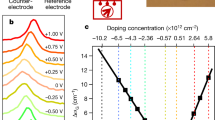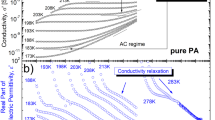Abstract
THE large dielectric absorption at low frequencies recently observed1 in crystalline long-chain alcohols has been shown to be probably due to a hydrogen bonding of the hydroxyl groups to form chains. Hydrogen-bonded hydroxyl groups are also present in the dihydric phenol quinol, according to a structure proposed from X-ray crystallographic data2, but in this case the hydrogen bonds form regular hexagons. With such a structure the resultant dipole moment should be zero and the compound should give no dielectric absorption. However, in recent measurements in this laboratory, considerable low-frequency absorption was observed in three samples of quinol crystallized from water, ethanol and methanol respectively. This absorption decreased with time of storage at room temperature, as shown in the graph (p. 1122) of the results for the sample crystallized from water. The curves are similar in shape to those obtained previously for n-hexadecyl alcohol3, in which the dielectric absorption was attributed to the presence of extensive hydrogen-bond chains, and it seems likely that the results for quinol can be similarly explained.
This is a preview of subscription content, access via your institution
Access options
Subscribe to this journal
Receive 51 print issues and online access
$199.00 per year
only $3.90 per issue
Buy this article
- Purchase on Springer Link
- Instant access to full article PDF
Prices may be subject to local taxes which are calculated during checkout
Similar content being viewed by others
References
Meakins, R. J., and Sack, R. A., Aust. J. Sci. Res., 4, No. 2, 213 (1951).
Palin, D. E., and Powell, H. M., J. Chem. Soc., 208 (1947).
Meakins, R. J., and Mulley, J. W., Aust. J. Sci. Res., 4, No. 3, 365 (1951).
Powell, H. M., J. Chem. Soc., 61 (1948).
Stearn, A. E., and Eyring, H., J. Chem. Phys., 5, 113 (1937).
Hamon, B. V. (in the press).
Author information
Authors and Affiliations
Rights and permissions
About this article
Cite this article
DRYDEN, J., MEAKINS, R. Low-Frequency Dielectric Absorption and Direct-Current Conductivity in Quinol. Nature 168, 1121–1122 (1951). https://doi.org/10.1038/1681121a0
Issue Date:
DOI: https://doi.org/10.1038/1681121a0
Comments
By submitting a comment you agree to abide by our Terms and Community Guidelines. If you find something abusive or that does not comply with our terms or guidelines please flag it as inappropriate.



